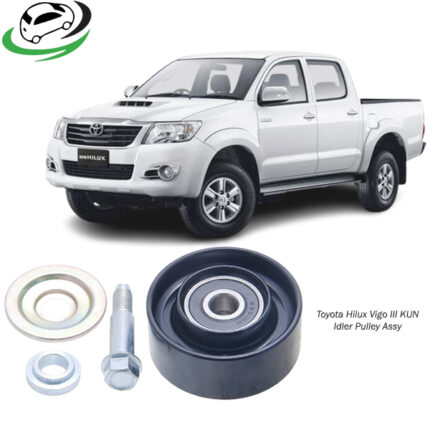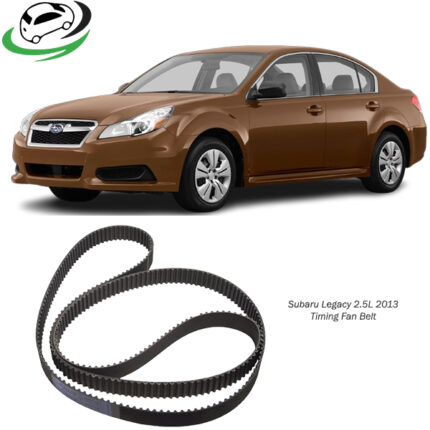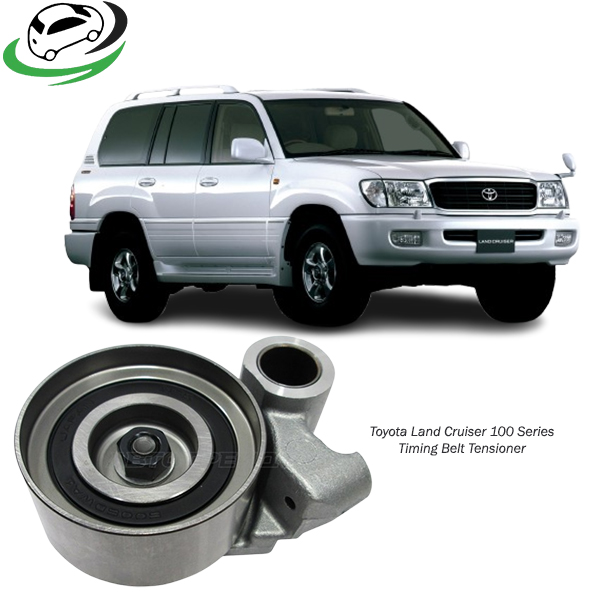-7%
Get Toyota Land Cruiser Prado 100 Series Timing Belt Tensioner ZA-62TB0629B29
The timing belt tensioner is an essential component of a vehicle’s engine, designed to ensure that the timing belt maintains the correct tension and alignment throughout its operation. Its function is crucial for maintaining engine timing and synchronization between the crankshaft and camshaft, which are responsible for the engine’s smooth operation. In this detailed explanation, we’ll explore the functions, benefits, and maintenance tips for timing belt tensioners.
1. Function of the Timing Belt Tensioner
The timing belt tensioner plays a pivotal role in ensuring the timing belt remains taut and correctly positioned during engine operation. The timing belt connects the crankshaft and camshaft(s), which must remain synchronized to ensure that the engine’s valves open and close at the correct intervals in relation to the pistons’ movement. Without a properly functioning timing belt and tensioner, the engine could suffer from poor performance, and in severe cases, catastrophic engine failure.
How It Works
The timing belt tensioner adjusts the tension on the belt, compensating for wear and slack that can occur over time. It typically includes a pulley mounted on an adjustable arm, which is either spring-loaded or hydraulically powered. The spring-loaded or hydraulic mechanism provides constant tension on the belt, preventing it from slipping or jumping teeth on the sprockets that link the crankshaft and camshaft.
- Spring-Loaded Tensioner: This type uses a coiled spring that applies pressure to the arm, maintaining constant tension on the belt. The spring ensures the tensioner can automatically adjust to changes in belt length due to wear or temperature variations.
- Hydraulic Tensioner: This system relies on hydraulic pressure to control the tensioner arm. It provides smoother adjustments and is generally more effective in high-performance engines or those subjected to variable loads.
The tensioner ensures that the timing belt operates within the correct parameters, reducing the risk of the belt becoming too loose or too tight, both of which could lead to timing misalignment and engine damage.
2. Benefits of a Well-Functioning Timing Belt Tensioner
A properly functioning timing belt tensioner offers several advantages that contribute to engine longevity, performance, and reliability.
a) Ensures Proper Engine Timing
The most significant benefit is that the tensioner ensures the timing belt maintains correct tension, thereby preserving the precise synchronization between the crankshaft and camshaft(s). This synchronization is essential for ensuring that the engine’s intake and exhaust valves open and close at the correct times. Any deviation in timing can lead to poor engine performance or engine damage.
b) Prevents Belt Slippage and Jumping
A loose timing belt can slip or jump over the teeth of the camshaft or crankshaft sprockets, leading to misfires or even catastrophic engine failure if valves and pistons collide. The tensioner keeps the belt tight, reducing the risk of these occurrences.
c) Reduces Engine Wear
By maintaining proper tension and reducing slack, the tensioner helps to prevent undue wear on the timing belt. Excessive slack can cause the belt to vibrate or rub against other components, which accelerates wear and tear. This means the timing belt, as well as the engine components it drives, last longer.
d) Minimizes Noise
An improperly tensioned timing belt can lead to whining, squealing, or ticking noises. A well-functioning tensioner ensures the belt runs smoothly, reducing engine noise and contributing to a quieter driving experience.
e) Enhances Fuel Efficiency
Maintaining proper timing ensures that the engine runs efficiently. A loose or misaligned timing belt can cause the engine to work harder than necessary, increasing fuel consumption. The tensioner plays a role in maintaining optimal timing, thereby improving fuel economy.
f) Improves Engine Performance
When the timing belt and associated components are functioning correctly, the engine can perform at its best. A timing belt tensioner that maintains the correct belt tension contributes to smoother acceleration, consistent power delivery, and overall improved engine performance.
3. Maintenance Tips for Timing Belt Tensioners
Since timing belt tensioners are critical for engine function, regular maintenance is essential to ensure they remain in good working condition. Here are several maintenance tips to help prolong the life of the tensioner and the overall engine system.
a) Regular Inspection
It’s important to inspect the timing belt and tensioner periodically. Look for signs of wear, cracks, or damage on the belt and listen for any unusual noises like squealing or rattling that could indicate a failing tensioner. If you notice any issues with the belt or tensioner, it’s crucial to address them promptly.
b) Timing Belt Replacement Intervals
Timing belts have recommended replacement intervals, usually between 60,000 to 100,000 miles, depending on the vehicle and manufacturer’s guidelines. It’s advisable to replace the timing belt and tensioner at the same time, as they experience similar wear. A failing tensioner can compromise a new belt, leading to premature failure, so they are often replaced together.
c) Monitor for Oil Leaks
Engine oil leaks can degrade the timing belt and tensioner. If oil comes into contact with these components, it can cause the belt to slip or the tensioner to malfunction. Regularly check for any oil leaks, particularly near the front of the engine where the timing components are located, and repair them promptly.
d) Address Warning Signs
If you notice any symptoms of a failing tensioner, such as engine misfires, unusual engine noise, or difficulty starting the engine, it’s important to get the system checked immediately. A tensioner that fails while the vehicle is in operation can cause significant engine damage, often leading to expensive repairs.
e) Professional Maintenance
While some vehicle owners may choose to inspect or replace certain components on their own, the timing belt system, including the tensioner, is best left to professionals. A timing belt replacement is a complex task that requires precise alignment. A misaligned belt or tensioner could lead to serious engine damage, so professional installation is strongly recommended.
4. Signs of a Faulty Timing Belt Tensioner
A failing tensioner can cause a variety of symptoms, and it’s crucial to recognize them before they lead to more severe engine damage. Here are some common signs of a faulty tensioner:
a) Unusual Noises
Whining, squealing, or grinding noises coming from the front of the engine are common signs that the tensioner is failing. These noises occur because the belt is either too loose or too tight.
b) Engine Misfires
When the timing belt loses tension, it can cause misalignment between the crankshaft and camshaft, resulting in engine misfires. Misfires occur when the engine’s cylinders fire incorrectly, leading to poor engine performance, rough idling, and increased emissions.
c) Visible Wear on the Belt
If the timing belt shows signs of uneven wear, glazing, or fraying, it could be a result of improper tension from a faulty tensioner. It’s important to replace both the belt and tensioner if these signs are present.
d) Vehicle Stalling or Difficulty Starting
A failing tensioner can cause the timing belt to slip, which may lead to engine stalling or difficulty starting the vehicle. If you experience these issues, have the timing system inspected immediately.
Conclusion
The timing belt tensioner is a critical component in ensuring the efficient and reliable operation of a vehicle’s engine. It plays a vital role in maintaining engine timing, preventing belt slippage, and reducing wear on the timing belt. Regular maintenance and timely replacement of the tensioner, along with the timing belt, can help avoid costly engine repairs and keep your vehicle running smoothly. Always adhere to manufacturer recommendations for replacement intervals and consult a professional mechanic to ensure proper installation and adjustment.
Follow us on Facebook for more parts.




Reviews
Clear filtersThere are no reviews yet.